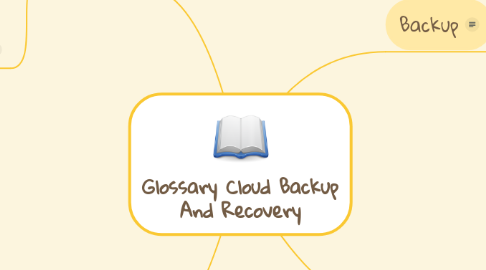
1. Cloud
1.1. Cloud computing
1.1.1. Web application
1.1.2. Clustering
1.1.3. Terminal services
1.1.3.1. Dumpturnals
1.1.3.2. Thin clients
1.1.4. Application servers
1.1.5. Virtualization
1.2. Cloud storage
1.2.1. Public
1.2.2. Amazon Cloud Drive
1.2.3. Microsoft Azure
1.2.4. Private
1.2.5. Hybrid
2. Data Storage
2.1. Data repository models
2.1.1. Unstructured
2.1.2. Backup rotantion schemes
2.1.2.1. First in, first out (FIFO) aka First come, first served (FCFS)
2.1.2.2. Grandfather-father-son
2.1.2.3. Tower of Hanoi
2.1.2.4. Weighted random distribution
2.1.2.5. Incremented media method
2.1.3. Full only/ System imaging
2.1.4. Incremental
2.1.5. Differential
2.1.6. Reverse delta
2.1.7. Continious data protection
2.2. Storage media
2.2.1. Magentic tape
2.2.2. Hard disk
2.2.3. Optical storage
2.2.4. Solid state storage
2.2.5. Tape library
2.2.5.1. Virtual tape library (VTL)
2.2.6. Remote backup service
2.2.7. Floppy disk
2.3. Managing the data repository
2.3.1. On-line
2.3.2. Near-line
2.3.3. Off-line
2.3.4. Off-site data protection
2.3.5. Backup site aka work area recovery site or disaster recovery center (DR center)
2.3.5.1. Cold site
2.3.5.2. Warm site
2.3.5.3. Hot site
2.4. Data types
2.4.1. Active archive
2.4.2. Deep archive
2.5. Data archiving
3. Backup
3.1. Backup software
3.1.1. Agentless backup
3.1.2. Agent-based
3.2. Backup policy
3.3. Process
3.3.1. Copy backup
3.3.2. Disk cloning
3.3.3. Disk image
3.3.4. Media spanning
3.3.5. Multistreaming
3.3.6. Near store
3.3.7. Remote store
3.3.8. Selection and extraction of data
3.3.8.1. File-level
3.3.8.1.1. Copying files
3.3.8.1.2. Partial file copying
3.3.8.1.3. Deleted files
3.3.8.2. Filesystem
3.3.8.2.1. Filesystem dump
3.3.8.2.2. Identification of changes
3.3.8.2.3. Versioning file system
3.3.8.3. Choosing level of data
3.3.8.4. "Live" data
3.3.8.4.1. Snapshot backup
3.3.8.4.2. Open file backup
3.3.8.4.3. Cold database backup
3.3.8.4.4. Hot database backup
3.3.8.5. Metadata
3.3.8.5.1. System description
3.3.8.5.2. Boot sector
3.3.8.5.3. Partition layout
3.3.8.5.4. File metadata
3.3.8.5.5. System metadata
3.3.9. Manipulation
3.3.9.1. Compression
3.3.9.2. Deduplication
3.3.9.3. Duplication
3.3.9.4. Multiplexing
3.3.9.5. Encryption
3.3.9.6. Refactoring
3.3.9.7. Staging
3.3.9.8. validating the reliability of the data
3.3.10. Managing the backup process
3.3.10.1. Objectives
3.3.10.1.1. Recovery Point Objective (RPO)
3.3.10.1.2. Recovery Time Objective (RTO)
3.3.10.1.3. Data security
3.3.10.1.4. Data retention period
3.3.10.2. Limitations
3.3.10.2.1. Backup window
3.3.10.2.2. Performance impact
3.3.10.2.3. Costs of hardware, software, labor
3.3.10.2.4. Network bandwidth
3.3.10.3. Implementation
3.3.10.3.1. Scheduling
3.3.10.3.2. Authentication
3.3.10.3.3. Chain of trust
3.3.10.4. Measuring the process
3.3.10.4.1. Backup validation
3.3.10.4.2. Reporting
3.3.10.4.3. Logging
3.3.10.4.4. Validation
3.3.10.4.5. Monitored backup
3.3.11. Sending to storage
3.4. Types
3.4.1. Daily backup
3.4.2. Differential backup
3.4.3. FlashBackup
3.4.4. Full backup
3.4.5. Hot backup
3.4.6. Incremental backup
3.4.6.1. Cumulative incremental backup
3.4.6.2. Incremental
3.4.6.3. Multilevel incremental
3.4.6.4. Reverse incremental
3.4.6.5. Incremental forever
3.4.6.6. Block level incremental
3.4.6.7. Byte level incremental
3.4.6.8. Forward Incremental-Forever
3.4.7. Normal backup
3.4.8. Site-to-site backup
3.4.9. Synthetic backup
3.4.10. Fuzzy backup
3.4.11. Bare-metal backup

